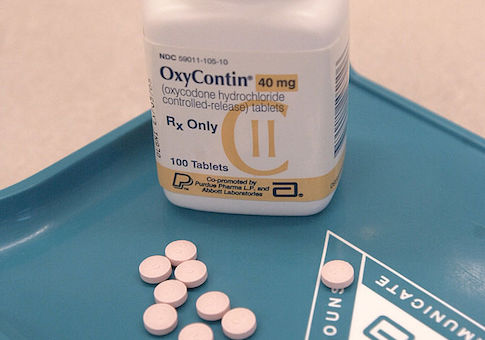Limiting the length of opioid prescriptions may end up increasing the number of new users, according to newly published research.
A paper released Monday found that a popular policy designed to combat opioid abuse may unintentionally expose more people to the highly addictive drugs. The paper is the work of Daniel W. Sacks, Alex Hollingsworth, Thuy D. Nguyen, and Kosali I. Simon, all researchers at Indiana University. They use a novel set of data from a "large, national insurer, with both employer-sponsored plans and Affordable Care Act Exchange plans" to look at how two policies — initial prescription limits and must-access prescription drug monitoring programs — affect "opioid-naïve" individuals' exposure to prescription painkillers.
Drug policy focuses on three groups: people who currently use drugs, people who used to use drugs, and people who do not yet use drugs. Policymakers, however, have yet to identify any solution that benefits all three groups. For example, supply-side interventions like banning certain substances will have a different impact on someone who is already heavily dependent — and thus has a fairly inelastic demand for their drug of choice — compared to someone who has never used the banned drug. Sacks and his colleagues looked specifically at prescription opioids, which are widely used and potentially lethal, to see which policies help prevent non-users from being exposed to, or becoming dependent upon, drugs.
Deaths involving prescription opioids like OxyContin have risen steadily over the past two decades, hitting roughly 17,000 in 2017. In response to this increase, many states implemented stringent regulations governing the prescription of these pills. One popular regulation is an initial prescription limit (IPL), which sets a maximum length for first-time users, usually around seven days. Another is the prescription drug-monitoring program (PDMP), a centralized database of opioid prescriptions that allows doctors to see a patient's opioid use history. Researchers were interested specifically in must-access PDMPs (MA-PDMP), which require a physician to consult the system before prescribing painkillers.
Research on both of these policies has tended to look only at the behavior of individuals already prescribed opioids. Sacks and his team analyzed the effectiveness of prescription limits and monitoring on patients who had never encountered opioids in the past. While monitoring programs slightly decrease the number of new opioid prescription recipients, prescription limits raise them. Specifically, the must-access monitoring programs cut the "hazard" of a new prescription by about 3 percent, while prescription limits increased it by about 4 percent.
Most prescriptions written before the anti-opioid reforms went into effect already fell below the threshold — 80 percent are for a length of seven days or fewer—according to data compiled by Sacks. However, once an IPL is implemented, physicians began writing more prescriptions in total, increasing the number of recipients. The result is more pills dispensed on net, even though the mean prescription length is about half a day shorter.
The authors theorize that this may be because IPLs act as a "reference point" for physicians, giving them a sense that they can write prescriptions "safely" as long as they stay under the limit. "The hypothesis here," the authors write, "is that physicians, who have recently been exposed to many warnings urging caution in opioid prescribing, see a law with a limit of 7 days supply and come to think that 7 days is relatively safe or socially acceptable."
Monitoring programs, by contrast, create "fixed costs" to issuing a new prescription, because they require the prescriber to take the time and effort to consult the system and log each new prescription.
"This hypothesis is consistent with the evidence in Buchmueller et al. (2018), who find that when Kentucky introduced its MA-PDMP, opioid prescribing fell, and many low-volume prescribers stopped prescribing entirely, relative to a control group of Indiana prescribers," Sacks et al. write. "Buchmueller et al. indicate that a likely reason for this … is that Kentucky's must-access provisions required prescribers to register with the database, creating a fixed cost of prescribing any opioid."
What to make of all of this? That depends on your policy priorities. If the goal is to reduce the number of people prescribed prescription opioids, then PDMPs are good, and IPLs are bad. This is bad news for Sen. Kirsten Gillibrand (D., N.Y.), who has proposed a nationwide IPL as part of her campaign for president.
On the other hand, the risk associated with an opioid prescription is directly proportional to its length, in two senses. One is that as prescriptions get longer, and especially exceed ten days, so too does risk of dependency. The other is that a longer prescription is less likely to be completed, and therefore more likely to be diverted, i.e. either stolen or sold for illicit use. Sacks et al. find that both IPLs and MA-PDMPs reduce the length of opioid prescriptions, even if the former also leads to more people getting them.
In reality, reducing both the number of prescriptions and their length is probably desirable, contingent on other concerns about the needs of chronic pain patients. What remains unclear — and a subject for future research — is which factor more effectively stops new users from getting hooked, and can therefore curb the ongoing drug crisis.
